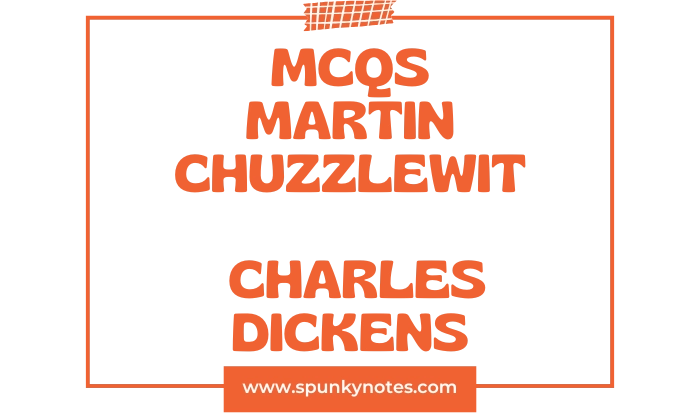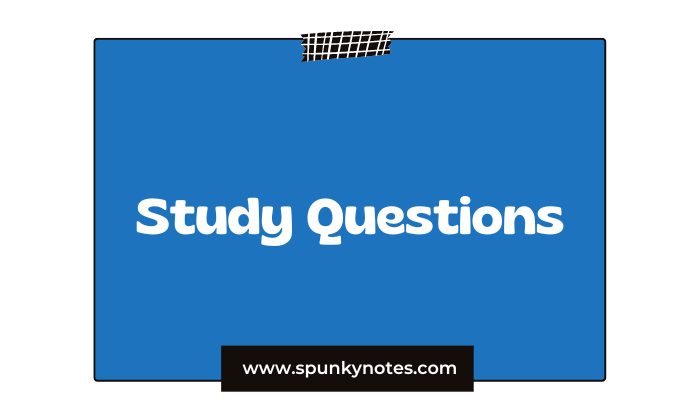
Martin Chuzzlewit MCQs
1. From whom did the Chuzzlewit family undoubtedly descend in a direct line?
A. William the Conqueror
B. Adam and Eve
C. Diggory Chuzzlewit
D. Lord No Zoo
2. What great event in English history was a Chuzzlewit associated with?
A. The War of the Roses
B. The Norman Invasion
C. The Gunpowder Plot
D. The Great Fire of London
3. What was Mr. Pecksniff’s profession?
A. Doctor and surveyor
B. Architect and land surveyor
C. Lawyer and builder
D. Priest and teacher
4. Who was the youth described as coming shortly to join Mr. Pecksniff’s establishment for an architectural education?
A. Tom Pinch
B. Jonas Chuzzlewit
C. Martin Chuzzlewit (Jr.)
D. John Westlock
5. Who was the former pupil that Mr. Pinch defended, noting his “little difference” with Mr. Pecksniff?
A. Martin Chuzzlewit
B. Montague Tigg
C. John Westlock
D. Chevy Slyme
6. What was the name of the Inn where the sick gentleman was staying?
A. The Half Moon and Seven Stars
B. The Griffin
C. The Blue Dragon
D. Todgers’s
7. What was the “peculiarity” of the gentleman named Slyme, according to Mr. Tigg?
A. He was perpetually round the corner
B. He wrote philosophical articles
C. He was extremely wealthy
D. He was a great artist
8. What organization were the Chuzzlewit family members said to be making a “union” against?
A. The gentleman with the dark lantern
B. The Spottletoes
C. The common enemy (the favorite/stranger)
D. Montague Tigg
9. What action was described as the whole family sitting down before the Blue Dragon to perform?
A. Eating a feast
B. Formally investing it (a state of siege)
C. Writing letters of appeal
D. Holding a prayer service
10. What dramatic news did Mr. Spottletoe gasp out regarding Old Martin Chuzzlewit?
A. He had left them a fortune
B. He had disappeared/gone
C. He was dying immediately
D. He had married the stranger
11. What quality did Pecksniff’s horse share with his master, according to slanderers?
A. Always going to go, but never going (full of promise, no performance)
B. Extreme modesty
C. A handsome figure
D. Stubbornness
12. What was Tom Pinch’s customary mood when talking about Mr. Pecksniff?
A. Anger
B. Tears of gratitude
C. Sarcastic wit
D. Indifference
13. What did Mark Tapley call Mrs. Lupin upon seeing her in the bar?
A. The Queen of England
B. The very pink and pine-apple
C. The strong-minded woman
D. The sweetest and best of women
14. What did Jonas Chuzzlewit advise Mr. Pecksniff to ask his father to be excused for?
A. Being a bully
B. Having a cold on his chest
C. Snoring too loudly
D. Dying so quickly
15. What gift did Tom Pinch pin inside the turned-down leaf of Martin’s book?
A. A bank note for twenty pounds
B. The address of Mary Graham
C. A half-sovereign
D. A letter of recommendation
16. Who was Martin surprised to find himself travelling with, waiting at the coach?
A. Mark Tapley
B. Tom Pinch
C. Anthony Chuzzlewit
D. Montague Tigg
17. What was the name of the “war correspondent” and associate of Colonel Diver?
A. La Fayette Kettle
B. Elijah Pogram
C. Major Pawkins
D. Jefferson Brick
18. What settlement were Martin and Mark traveling to, known for its “awful lovely” location?
A. New York
B. New Thermopylae
C. Eden
D. Massachusetts
19. What did the agent Mr. Scadder immediately produce when Martin enquired about Eden?
A. A list of rich residents
B. Maps and plans
C. A rifle
D. A shovel
20. What animal did General Choke denounce in his letter, claiming its “rampant cruelty” afflicted the world?
A. The American Eagle
B. The British Lion
C. The White Ant
D. The Wild Irish Bull
21. What did Martin resolve to do regarding his former conduct upon leaving Eden?
A. Write a book about America
B. Not be a bad scholar to Mark’s advice
C. Return to England in disgrace
D. Challenge Pecksniff to a duel
22. After Anthony Chuzzlewit’s death, what phrase did Jonas take for his motto regarding funeral expenses?
A. Save where you can
B. Spend, and spare not!
C. Silence is golden
D. Filial piety
23. What was Mrs. Gamp’s profession?
A. Undertaker
B. Midwife/nurse
C. Inn hostess
D. Coal merchant
24. What name did Mrs. Gamp frequently cite as her good friend?
A. Mrs. Prig
B. Mrs. Lupin
C. Mrs. Mould
D. Mrs. Harris
25. What did Mrs. Gamp always request be left on the chimney-piece for her?
A. A copy of a paper
B. A glass of water
C. The bottle of liquor
D. A new blanket
26. What was the name of the insurance company Montague Tigg and David Crimple founded?
A. The London Life and Loan
B. The Anglo-Bengalee Disinterested Loan and Life Insurance Company
C. The Golden Ball Investment Firm
D. The Chuzzlewit Family Assurance
27. What was the peculiar profession/role of Mr. Nadgett?
A. Chairman of the Board
B. Underwriter
C. Investigator/spy (the man who made enquiries)
D. Medical officer
28. What did the old man Anthony Chuzzlewit give to Mr. Pecksniff, almost with his latest breath, to remember?
A. A large sum of money
B. A caution regarding Jonas
C. A warning about Tigg
D. Advice about Charity
29. Which daughter did Jonas eventually marry?
A. Mercy
B. Charity
C. The deaf cousin
D. Mrs. Lupin’s niece
30. What did Jonas use as an analogy for his determination to crush his wife’s spirit?
A. Breaking nutshells
B. Killing an enemy
C. Taming a horse
D. Winning a fortune
31. What shocking fact did Jonas learn from Montague that caused his face to change color?
A. Montague knew a secret about Jonas’s past
B. Tigg was cheating him financially
C. His wife was leaving him
D. The Anglo-Bengalee was bankrupt
32. What was the name of the man who died, whose murder Jonas was apprehended for?
A. Anthony Chuzzlewit
B. Mr. Montague (Tigg)
C. Chevy Slyme
D. Mr. Mould
33. What had Lewsome procured for Jonas, for which he was paid five pounds?
A. Poisonous drugs
B. A ticket to America
C. A forged letter
D. A false identity
34. What did Anthony Chuzzlewit take into his possession after discovering Jonas’s intention to poison him?
A. The knife
B. The money
C. The mixture/drugs
D. A gun
35. What was Anthony Chuzzlewit’s dying plea to Chuffey?
A. Get revenge
B. Keep quiet
C. Spare him, Chuff!
D. Tell the truth
36. How did Jonas attempt to stop his ears when Nadgett revealed the details of the murder?
A. By yelling loudly
B. By running away
C. With his fettered arms
D. By throwing nuts at them
37. When Tom left Pecksniff’s house, what did he miss most about Salisbury market?
A. The noise of fowls
B. The array of vegetables
C. A statue he had set up in his heart (of Pecksniff)
D. The bustling crowds
38. After his disappointment in Pecksniff, what piece of wisdom (upheld by poets) did Tom refrain from acting on?
A. Mistrusting all mánkind
B. Seeking vengeance immediately
C. Writing a novel
D. Returning home to Wiltshire
39. What name was on the office door of Tom’s employer’s chambers, confusing John Westlock?
A. Mr. Fips, of Austin Friars
B. Martin Chuzzlewit
C. Mr. Slyme
D. Mr. Nadgett
40. Upon returning to the Dragon, what did Martin tell Mrs. Lupin the less they spoke of, referring to America?
A. The cost of the trip
B. The experience
C. The country
D. The American people
41. When Martin (Sr.) confronted Pecksniff, what did Pecksniff call the assembled family members?
A. Allies
B. Vermin and swarmers
C. Gentle friends
D. Good people
42. What did Martin (Sr.) claim Pecksniff failed to do, confirming his servile nature, when Martin suggested disinheriting his grandson?
A. Offer one word of remonstrance
B. Demand money
C. Refuse the terms
D. Look him in the eye
43. What final, highly emotional statement did Pecksniff make, regarding his burial, as he took his leave of Martin (Sr.)?
A. That he was without reproach
B. That he forgave Martin
C. That he would be revenged
D. That he was a victim
44. What was the underlying “root of the vile tree” that old Martin sought to suppress in his final scheme?
A. Pride
B. Avarice
C. Self (selfishness)
D. Hypocrisy
45. What condition did Merry set for marrying Jonas, which she claimed she told him?
A. That she would hate and teaze him all her life
B. That he must give her all his money
C. That she would leave him in America
D. That he must apologize to her sister
46. Who was the dismal young gentleman engaged to Miss Charity Pecksniff?
A. Mr. Moddle
B. Mr. Jinkins
C. Mr. George Chuzzlewit
D. John Westlock
47. Why did Martin (Sr.) allow Mary Graham to remain his companion, despite his general coldness to his grandson?
A. He felt pity and tenderness for her
B. She had nowhere else to go
C. She was his true relation
D. Pecksniff insisted on it
48. What news was revealed about Augustus Moddle just before his marriage to Charity?
A. He had run off to Van Diemen’s Land
B. He had married Mercy instead
C. He was sick in bed
D. He inherited a fortune
49. What was the symbolic change regarding Tom Pinch’s harpsichord that indicated Mary Graham’s influence?
A. He bought a new one
B. It was sold for money
C. An incorrigible note was fixed
D. He stopped playing it
50. What did Martin (Jr.) and Ruth begin doing for Tom Pinch after learning his secret sorrow?
A. They bought him a select library and built him an organ
B. They offered him money
C. They took him travelling
D. They hired him a servant
Brief Overview
Martin Chuzzlewit is a novel about selfishness, greed, and personal change. The story centers on old Martin Chuzzlewit, a rich man whose relatives try to please him only to get his money.
His grandson, also named Martin, starts out proud and self-centered. After a dispute with his grandfather, he goes to America hoping to become rich quickly.
In America, he faces sickness, hardship, and false promises in a place called Eden. These struggles slowly teach him kindness and the value of hard work.
He returns to England with his loyal friend Mark Tapley, wanting to live a better and more honest life. At the same time, a cunning man named Seth Pecksniff is exposed for his lies and fake goodness.
In the end, old Martin sees his grandson has changed for the better and accepts him again. The story shows how true goodness comes from honesty, effort, and caring for others.

